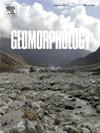Quaternary fluvial archives from Asian rivers: Reflections of tectonic activity, crustal processes and climatic variation
IF 3.1
2区 地球科学
Q2 GEOGRAPHY, PHYSICAL
引用次数: 0
Abstract
This paper reviews the fluvial archives from selected Asian rivers, exploring the extent to which they inform about the influences upon fluvial evolution of tectonic activity, crustal processes and patterns of climatic change. The drainage systems selected for review include examples of different size and in different parts of the continent, the criterion for selection being recent research undertaken on them that has provided updated data on their fluvial archives. Patterns revealed include a strong record of uplift from SW Asia: Anatolia, the Levant and Mesopotamia; in the last two of these regions the fluvial archives incorporate important evidence for early human occupation. Rivers flowing over cratonic crust across Siberia to the Arctic Ocean lack evidence for progressive uplift but can still reveal long-timescale fluvial archives; they can also represent important contexts for regional archaeological records, as well as for palaeontology. The largest Asian rivers include those draining from the Himalayan–Tibetan uplands, where the drainage has evolved alongside the World's most extreme recent orogenesis. They record complex reorganization of drainage, including the diversion of the Yarlung Tsangpo from the Irrawaddy to the Brahmaputra and of the Yangtze from the Red River. The Yellow River, meanwhile, has been formed from the progressive capture of formerly endorheic basins on the Tibetan Plateau, while drainage at the northern edge of the Tibetan Plateau has evolved in response to recently uplifted mountain chains. The selected examples provide insight into the interaction of tectonic, epeirogenic and climatic influences on fluvial evolution and associated palaeoenvironments.
亚洲河流的第四纪河流档案:构造活动、地壳过程和气候变化的反映
本文回顾了亚洲部分河流的河流档案,探讨了它们对构造活动、地壳过程和气候变化模式对河流演化的影响程度。选择供审查的排水系统包括在大陆不同地区的不同规模的例子,选择的标准是最近对这些系统进行的研究,这些研究提供了有关其河流档案的最新数据。揭示的模式包括来自西南亚的强隆起记录:安纳托利亚、黎凡特和美索不达米亚;在最后两个地区,河流档案包含了早期人类居住的重要证据。流经西伯利亚到北冰洋的克拉通地壳的河流缺乏渐进式隆升的证据,但仍然可以揭示长时间尺度的河流档案;它们也可以代表区域考古记录和古生物学的重要背景。亚洲最大的河流包括那些从喜马拉雅-西藏高地流出的河流,那里的排水系统是随着世界上最近最极端的造山运动而演变的。它们记录了复杂的排水重组,包括雅鲁藏布江从伊洛瓦底江转向雅鲁藏布江,长江从红河转向雅鲁藏布江。与此同时,黄河是由青藏高原上以前的内陆盆地逐渐形成的,而青藏高原北缘的排水系统则是随着最近山脉的抬升而演变的。所选的例子有助于深入了解构造、造陆和气候对河流演化和相关古环境的相互作用。
本文章由计算机程序翻译,如有差异,请以英文原文为准。
求助全文
约1分钟内获得全文
求助全文
来源期刊

Geomorphology
地学-地球科学综合
CiteScore
8.00
自引率
10.30%
发文量
309
审稿时长
3.4 months
期刊介绍:
Our journal''s scope includes geomorphic themes of: tectonics and regional structure; glacial processes and landforms; fluvial sequences, Quaternary environmental change and dating; fluvial processes and landforms; mass movement, slopes and periglacial processes; hillslopes and soil erosion; weathering, karst and soils; aeolian processes and landforms, coastal dunes and arid environments; coastal and marine processes, estuaries and lakes; modelling, theoretical and quantitative geomorphology; DEM, GIS and remote sensing methods and applications; hazards, applied and planetary geomorphology; and volcanics.
 求助内容:
求助内容: 应助结果提醒方式:
应助结果提醒方式:


